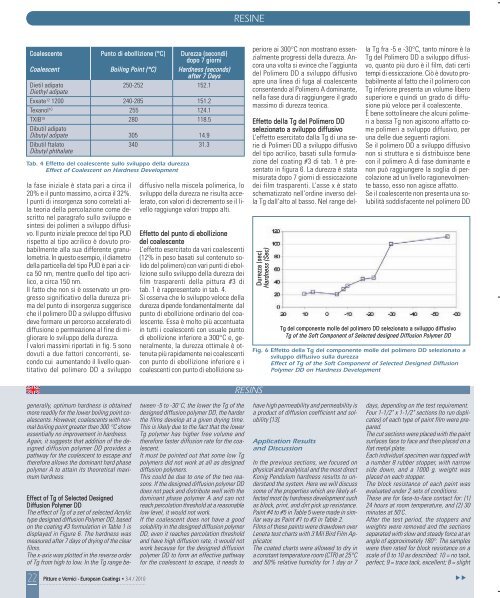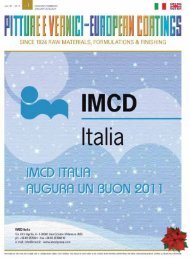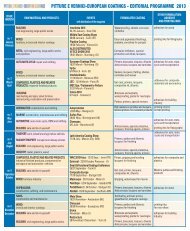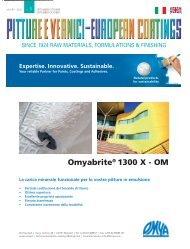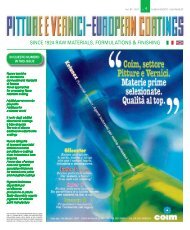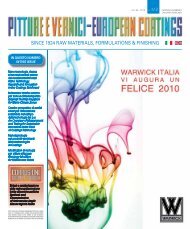You also want an ePaper? Increase the reach of your titles
YUMPU automatically turns print PDFs into web optimized ePapers that Google loves.
Coalescente Punto di ebollizione (°C) Durezza (secondi)<br />
dopo 7 giorni<br />
Coalescent Boiling Point (°C) Hardness (seconds)<br />
after 7 Days<br />
Dietil adipato 250-252 152.1<br />
Diethyl adipate<br />
Exxate 12 1200 240-285 151.2<br />
Texanol 10 255 124.1<br />
TXIB 10 280 118.5<br />
Dibutil adipato<br />
Dibutyl adipate 305 14.9<br />
Dibutil ftalato 340 31.3<br />
Dibutyl phthalate<br />
Tab. 4 Effetto del coalescente sullo sviluppo della durezza<br />
Effect of Coalescent on Hardness Development<br />
la fase iniziale è stata pari a circa il<br />
20% e il punto massimo, a circa il 32%.<br />
I punti di insorgenza sono correlati alla<br />
teoria della percolazione come descritto<br />
nel paragrafo sullo sviluppo e<br />
sintesi dei polimeri a sviluppo diffusivo.<br />
Il punto iniziale precoce del tipo PUD<br />
rispetto al tipo acrilico è dovuto probabilmente<br />
alla sua differente granulometria.<br />
In questo esempio, il diametro<br />
della particella del tipo PUD è pari a circa<br />
50 nm, mentre quello del tipo acrilico,<br />
a circa 150 nm.<br />
Il fatto che non si è osservato un progresso<br />
significativo della durezza prima<br />
del punto di insorgenza suggerisce<br />
che il polimero DD a sviluppo diffusivo<br />
deve formare un percorso accelerato di<br />
diffusione o permeazione al fine di migliorare<br />
lo sviluppo della durezza.<br />
I valori massimi riportati in fig. 5 sono<br />
dovuti a due fattori concorrenti, secondo<br />
cui aumentando il livello quantitativo<br />
del polimero DD a sviluppo<br />
generally, optimum hardness is obtained<br />
more readily for the lower boiling point coalescents.<br />
However, coalescents with normal<br />
boiling point greater than 300 °C show<br />
essentially no improvement in hardness.<br />
Again, it suggests that addition of the designed<br />
diffusion polymer DD provides a<br />
pathway for the coalescent to escape and<br />
therefore allows the dominant hard phase<br />
polymer A to attain its theoretical maximum<br />
hardness.<br />
Effect of Tg of Selected Designed<br />
Diffusion Polymer DD<br />
The effect of Tg of a set of selected Acrylic<br />
type designed diffusion Polymer DD, based<br />
on the coating #3 formulation in Table 1 is<br />
displayed in Figure 6. The hardness was<br />
measured after 7 days of drying of the clear<br />
films.<br />
The x-axis was plotted in the reverse order<br />
of Tg from high to low. In the Tg range be-<br />
diffusivo nella miscela polimerica, lo<br />
sviluppo della durezza ne risulta accelerato,<br />
con valori di decremento se il livello<br />
raggiunge valori troppo alti.<br />
Effetto del punto di ebollizione<br />
del coalescente<br />
L’effetto esercitato da vari coalescenti<br />
(12% in peso basati sul contenuto solido<br />
del polimero) con vari punti di ebollizione<br />
sullo sviluppo della durezza dei<br />
film trasparenti della pittura #3 di<br />
tab. 1 è rappresentato in tab. 4.<br />
Si osserva che lo sviluppo veloce della<br />
durezza dipende fondamentalmente dal<br />
punto di ebollizione ordinario del coalescente.<br />
Essa è molto più accentuata<br />
in tutti i coalescenti con usuale punto<br />
di ebollizione inferiore a 300°C e, generalmente,<br />
la durezza ottimale è ottenuta<br />
più rapidamente nei coalescenti<br />
con punto di ebollizione inferiore e i<br />
coalescenti con punto di ebollizione su-<br />
tween -5 to -30 o<br />
C, the lower the Tg of the<br />
designed diffusion polymer DD, the harder<br />
the films develop at a given drying time.<br />
This is likely due to the fact that the lower<br />
Tg polymer has higher free volume and<br />
therefore faster diffusion rate for the coalescent.<br />
It must be pointed out that some low Tg<br />
polymers did not work at all as designed<br />
diffusion polymers.<br />
This could be due to one of the two reasons.<br />
If the designed diffusion polymer DD<br />
does not pack and distribute well with the<br />
dominant phase polymer A and can not<br />
reach percolation threshold at a reasonable<br />
low level, it would not work.<br />
If the coalescent does not have a good<br />
solubility in the designed diffusion polymer<br />
DD, even it reaches percolation threshold<br />
and have high diffusion rate, it would not<br />
work because for the designed diffusion<br />
polymer DD to form an effective pathway<br />
for the coalescent to escape, it needs to<br />
RESINE<br />
RESINS<br />
periore ai 300°C non mostrano essenzialmente<br />
progressi della durezza. Ancora<br />
una volta si evince che l’aggiunta<br />
del Polimero DD a sviluppo diffusivo<br />
apre una linea di fuga al coalescente<br />
consentendo al Polimero A dominante,<br />
nella fase dura di raggiungere il grado<br />
massimo di durezza teorica.<br />
Effetto della Tg del Polimero DD<br />
selezionato a sviluppo diffusivo<br />
L’effetto esercitato dalla Tg di una serie<br />
di Polimeri DD a sviluppo diffusivo<br />
del tipo acrilico, basati sulla formulazione<br />
del coating #3 di tab. 1 è presentato<br />
in figura 6. La durezza è stata<br />
misurata dopo 7 giorni di essiccazione<br />
dei film trasparenti. L’asse x è stato<br />
schematizzato nell’ordine inverso della<br />
Tg dall’alto al basso. Nel range del-<br />
have high permeability and permeability is<br />
a product of diffusion coefficient and solubility<br />
[13].<br />
Application Results<br />
and Discussion<br />
In the previous sections, we focused on<br />
physical and analytical and the most direct<br />
Konig Pendulum hardness results to understand<br />
the system. Here we will discuss<br />
some of the properties which are likely affected<br />
most by hardness development such<br />
as block, print, and dirt pick up resistance.<br />
Paint #4 to #5 in Table 5 were made in similar<br />
way as Paint #1 to #3 in Table 2.<br />
Films of these paints were drawdown over<br />
Leneta test charts with 3 Mil Bird Film Applicator.<br />
The coated charts were allowed to dry in<br />
a constant temperature room (CTR) at 25°C<br />
and 50% relative humidity for 1 day or 7<br />
la Tg fra -5 e -30°C, tanto minore è la<br />
Tg del Polimero DD a sviluppo diffusivo,<br />
quanto più duro è il film, dati certi<br />
tempi di essiccazione. Ciò è dovuto probabilmente<br />
al fatto che il polimero con<br />
Tg inferiore presenta un volume libero<br />
superiore e quindi un grado di diffusione<br />
più veloce per il coalescente.<br />
È bene sottolineare che alcuni polimeri<br />
a bassa Tg non agiscono affatto come<br />
polimeri a sviluppo diffusivo, per<br />
una delle due seguenti ragioni.<br />
Se il polimero DD a sviluppo diffusivo<br />
non si struttura e si distribuisce bene<br />
con il polimero A di fase dominante e<br />
non può raggiungere la soglia di percolazione<br />
ad un livello ragionevolmente<br />
basso, esso non agisce affatto.<br />
Se il coalescente non presenta una solubilità<br />
soddisfacente nel polimero DD<br />
Fig. 6 Effetto della Tg del componente molle del polimero DD selezionato a<br />
sviluppo diffusivo sulla durezza<br />
Effect of Tg of the Soft Component of Selected Designed Diffusion<br />
Polymer DD on Hardness Development<br />
days, depending on the test requirement.<br />
Four 1-1/2" x 1-1/2" sections (to run duplicates)<br />
of each type of paint film were prepared.<br />
The cut sections were placed with the paint<br />
surfaces face to face and then placed on a<br />
flat metal plate.<br />
Each individual specimen was topped with<br />
a number 8 rubber stopper, with narrow<br />
side down, and a 1000 g. weight was<br />
placed on each stopper.<br />
The block resistance of each paint was<br />
evaluated under 2 sets of conditions.<br />
These are for face-to-face contact for: (1)<br />
24 hours at room temperature, and (2) 30<br />
minutes at 50 o<br />
C.<br />
After the test period, the stoppers and<br />
weights were removed and the sections<br />
separated with slow and steady force at an<br />
angle of approximately 180°. The samples<br />
were then rated for block resistance on a<br />
scale of 0 to 10 as described: 10 = no tack,<br />
perfect; 9 = trace tack, excellent; 8 = slight<br />
22 Pitture e Vernici - European Coatings • 3-4 / <strong>2010</strong><br />
▼<br />
▼<br />
Durezza (sec)<br />
Hardness (Sec)<br />
Tg del componente molle del polimero DD selezionato a sviluppo diffusivo<br />
Tg of the Soft Component of Selected designed Diffusion Polymer DD


